PARASOL STARS
THE STORY OF BUBBLE BOBBLE III
|
|

|

|
|
パラソルスター
©Taito Corp. 1991
Release : 1991-02-15 (¥6600)
HuCard (3 Mbits) TP03017
Action / Platform game
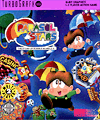

|
Released in America as
PARASOL STARS
( TWG030701 )
|
|
Parasol Stars is a cute platform game by Taito and the (often forgotten)
sequel of Rainbow Islands (itself sequel of the classic Bubble Bobble).
Bubby and Bobby, the two main protagonists of the series, are back. Well,
fans of Taito's classic will undoubtedly remember that the two dinosaurs regained
their beloved human forms at the end of Bubble Bobble... and, just like in
Rainbow Islands, this new appearance hasn't impaired their ability to fight.
The objective of the game is to save all the planets dotted around the galaxy, which,
one after the other, send distress signals and ask for help. And, as in grand
Bubble Bobble tradition, each level must be cleared of enemies in order to
move to the next area. However, this time around, Bubby and Bobby
don't throw bubbles or rainbows, but come equipped instead with colourful magic
umbrellas. Although the circular devices can be used to shield the boys against
enemy projectiles, or act as parachutes and cushion their fall, they also have
another crucial and unique ability - with them, they can stun enemies
and throw them around the playfield like rag dolls. Another essential aspect of the
game are water droplets - they usually fall from the ceiling and can be collected
with the umbrellas and be later released on unsuspecting enemies. Additionally,
they come in different flavors and although they start as plain and simple rain
droplets, some release fire, lightning bolts and swirling magic stars later
in the game. Finally, and in the Bubble Bobble tradition, the game is riddled
with a plethora of miscellaneous power ups and items, such as Speed Boots, Potions (turn
the whole playfield into bonus items), Magic Rings and Crosses
(kill enemies on screen) to only name a few. Parasol Stars consists of
eight themed worlds (with an additional two hidden worlds) and also includes a
two-simultaneous player mode.
|
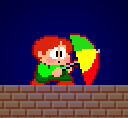 Parasol Stars was first released for the PC Engine system in 1991
(version tested here), and it was later converted by Ocean for the
Game Boy (1991), NES (1991), Commodore Amiga (1992) and
Atari ST (1992). The game was also announced for the ZX Spectrum
and Commodore 64, but was later cancelled (urban legend claims that the
main programmer's home at Ocean was robbed, and that the source code was
reported stolen in the unfortunate incident...). Although Parasol Stars
is technically the third game in the popular Bubble Bobble series (hence
the game's tag-line "The Story of Bubble Bobble III"), it was never released
as an arcade machine unlike its predecessors. Additionally, the arcade game
Bubble Memories released in 1995 also received the tag-line
"The Story of Bubble Bobble III" - which is rather interesting because
Bubble Memories followed Bubble Symphony released in 1994, which
is also known as Bubble Bobble II. And to confuse the Bubble Bobble
chronology even more, Ocean renamed its ports of Parasol Stars and
added the tag-line Rainbow Islands II... This is why Rainbow Islands
and Parasol Stars are often considered as spin-offs rather than true sequels
to Bubble Bobble - well, Fukio Mitsuji, creator of Bubble Bobble
who sadly passed away in December 2008,
admitted in an interview that, when he started working on Rainbow Islands,
he was determined to create a different game than Bubble Bobble (although he
considered it as a sequel to Taito's classic). It is just
a blind guess, but Rainbow Islands never gained the immense popularity than
Bubble Bobble did,
and this is probably why Taito decided to start again clean when they released
Bubble Symphony and Bubble Memories. Keep in mind that the successful
Puzzle Bobble hit the arcades in 1994, the same year as Bubble Symphony,
and it featured Bubblun and Bobblun in their dragon forms (who may
have more marketing appeal than the two boys).
Parasol Stars was first released for the PC Engine system in 1991
(version tested here), and it was later converted by Ocean for the
Game Boy (1991), NES (1991), Commodore Amiga (1992) and
Atari ST (1992). The game was also announced for the ZX Spectrum
and Commodore 64, but was later cancelled (urban legend claims that the
main programmer's home at Ocean was robbed, and that the source code was
reported stolen in the unfortunate incident...). Although Parasol Stars
is technically the third game in the popular Bubble Bobble series (hence
the game's tag-line "The Story of Bubble Bobble III"), it was never released
as an arcade machine unlike its predecessors. Additionally, the arcade game
Bubble Memories released in 1995 also received the tag-line
"The Story of Bubble Bobble III" - which is rather interesting because
Bubble Memories followed Bubble Symphony released in 1994, which
is also known as Bubble Bobble II. And to confuse the Bubble Bobble
chronology even more, Ocean renamed its ports of Parasol Stars and
added the tag-line Rainbow Islands II... This is why Rainbow Islands
and Parasol Stars are often considered as spin-offs rather than true sequels
to Bubble Bobble - well, Fukio Mitsuji, creator of Bubble Bobble
who sadly passed away in December 2008,
admitted in an interview that, when he started working on Rainbow Islands,
he was determined to create a different game than Bubble Bobble (although he
considered it as a sequel to Taito's classic). It is just
a blind guess, but Rainbow Islands never gained the immense popularity than
Bubble Bobble did,
and this is probably why Taito decided to start again clean when they released
Bubble Symphony and Bubble Memories. Keep in mind that the successful
Puzzle Bobble hit the arcades in 1994, the same year as Bubble Symphony,
and it featured Bubblun and Bobblun in their dragon forms (who may
have more marketing appeal than the two boys).
|
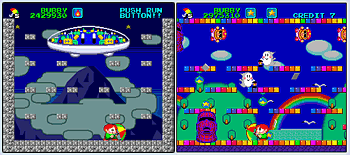 Parasol Stars is packed with an extensive list of Taito references
and cameos, such as (obviously) Rainbow Island (world 8's main theme) and
Bubble Bobble (hidden world's 9), but also Space Invaders (large
space ship enemies, as well as small invaders featured in the Bubble Bobble world),
Arkanoid (DOH, the large Moai head, appears as an enemy) and
Chack'n Pop
(the second hidden world is based on Chack'n Pop and
features Chack'n, Monstas and Mightas).
Parasol Stars is packed with an extensive list of Taito references
and cameos, such as (obviously) Rainbow Island (world 8's main theme) and
Bubble Bobble (hidden world's 9), but also Space Invaders (large
space ship enemies, as well as small invaders featured in the Bubble Bobble world),
Arkanoid (DOH, the large Moai head, appears as an enemy) and
Chack'n Pop
(the second hidden world is based on Chack'n Pop and
features Chack'n, Monstas and Mightas).
|
Teaser text from the American version:
Break out the bandages and get ready for some finger-searing action!
Join Bubby on his latest quest to save the universe, this time with a
Magic Umbrella. Umbrella !? Yes, Umbrella! This powerful Parasol puts
the elements themselves at your command! Shock the tonnage out of the
whales with Lightning! Fry the feathers off the crazed, beady-eyed birds
with Fire! Or, drown the demented dinosaurs with a tidal wave of
Raindrops! Need help? Your buddy Bobby is always nearby. Have a
friend plug into your TurboTap and blast into two player simultaneous
play. Be prepared for a quest that will take you to eight amazing planets,
forcing you to uncover the secret that will unleash the Parasol Stars!
|
Game Staff (Copied from the end credits) :
|
STAFF
Executive Producer
Takao Ueno
Producer
Tomohiro Nishikado
Director & Programmer
Haruo Suzuki
Programmer
Sera Kawano
|
|
Character Designers
Light Stone
Keishi Itoh
Kazuhiro Ohhara
Sound
Yasuko
World Creators
Kawauso Ishii
Flgon Kuroda
Yasutaka Ohgou
|
|
Special Thanks to
Team Bubble Bobble
Team Rainbow Project
Omake KZM
KHK
MR2 Tanaka
Youchi Itoh
Taka-P
K. Gardner
Shigeki Sugano
Charry Suzuki
Gota Goto
Misato Takahashi
"Pic.R"
Akira Yanagisawa
|
|
Story & Game Design
Talk Uchimura
THANK YOU VERY MUCH !
FOR YOUR PLAYING !
Presented by
TAITO
|
|
O
M
A
K
E
|
|
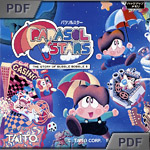
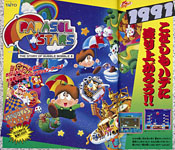
|
|
|
Click on picture to enlarge |
S
E
C
R
E
T
S
|
|
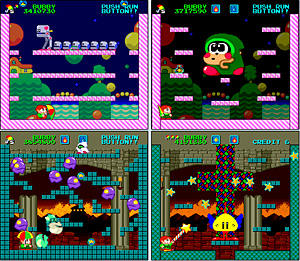 Three stars miracle!
Three stars miracle!
Various miracle icons can be collected throughout the game, from
Flames, Sparks and Stars. Although most of the
combinations of three unlock all kind of "Miracle" bonuses and
extra lives, a special one unlocks bonus rooms! Collecting
three stars actually unlocks a bonus room after the area's
boss with a large coin worth 100,000 points!
And there is more to it. Read on. If you manage to collect
three stars before you reach the final boss, then you will unlock
two new worlds! This is rather tricky to achieve though - the last
area only contains two stars so you must reach the last world
with at least one star. This will unlock the Bubble Bobble World
as well as the Chack'n Pop world! (pictures on the right).
This also leads to the real final boss and the
true ending of the game.
|
|
|
|
LK

|
|
Add your Pov here !
|
P
O
V
s
|
|
I still wonder to this day why Taito never released Parasol Stars
as an arcade game, and this may have definitively contributed to the lack of
recognition this game has gotten (although it was popular in Europe, thanks to
the folks at Ocean). Personally, I feel that Parasol Stars is a lot
closer to its Bubble Bobble roots than Rainbow Islands, and the game
is whole lot more fun too. The gameplay is absolutely sublime and controls are
intuitive and instinctive, and well, picking up enemies and throwing them across
the screen is utterly fun. Then, as the special water droplets appear, the
gameplay takes a different turn and keeps surprising you with new subtle flavors.
Additionally, the game is beautiful to look at, with lines of bonuses popping
out of existence as you throw enemies across the screen, or legions of large foes
ready to crush you like a jelly bean. It is also packed with secrets and hidden
goodies to unlock, as well as two awesome secret worlds. So, all in all,
Parasol Stars is a timeless classic and is still a blast to play, and
if the cute setting and characters don't bother you, then I highly advice you
to pick up this game right away (despite its hefty price tag...)
|
|
|
|